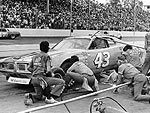
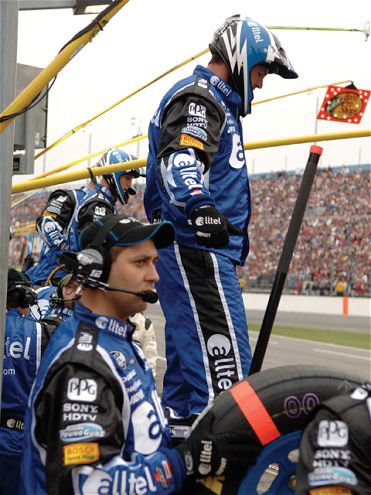
Top-flight safety equipment isn't just for drivers anymore. More manufacturers are coming out with innovative designs to keep you safe while you're working on your race car. Let's face it, the pit area at any racetrack isn't the safest place on the face of the earth. The side of the pit road wall you are standing on has a lot to do with the type of safety equipment you require. And many sanctions leave those decisions up to you, the racer. We're going to take a look at both sides of the fence, or wall as the case may be.
Inside The Wall
It's a hot, steamy Saturday night at your local dirt track. Your driver has just completed his heat race and banged up the front quarter-panel. He complains of a strange noise in the motor. You open the hood to investigate, setting your tools and a hammer on the fender. You're just reaching down into the motor when Uncle Joey waltzes by, eating a hot dog, and bumps into you. Your forearm gets a little too close to the header, and psssttt. As you reel back in pain, you knock the hammer off the fender and it lands squarely on your big toe. You've burned your arm and broken your toe. Thanks a lot, Uncle Joey! Now, while seemingly far-fetched, that scenario is not out of the realm of possibility-especially if you're not wearing the right safety equipment.
For those of you on the "safe" side of the pit wall, there are three basic items you should always have with you: gloves, the proper shoes, and eye protection. Let's take a look at each one.
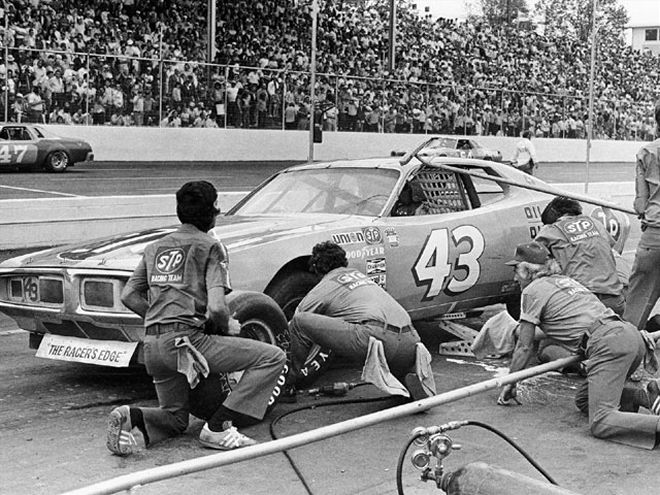
Gloves The mechanic glove revolution started back in 1991 in the motocross world. A group of guys began making gloves for motorcycle mechanics to protect their hands when changing tires. The first wrench to use the gloves was Brian Lunniss, the chief mechanic for famed Yamaha factory rider Damon Bradshaw. Lunniss began telling his friends, many of whom worked for top NASCAR teams, about the gloves. The rest, as they say, is history. Within a year, the newly named Mechanix Glove was all the rage in NASCAR, and Mechanix Wear was born. The second motorsports glove company, Ringers Gloves, came along in 1996. Now, a decade later, almost every safety equipment company offers a mechanic glove of some type.
There are gloves with fingers, gloves without fingers, gloves with gel inserts to resist impacts, vented gloves for hot weather, insulated gloves for cold weather, and more. Some are fire-retardant, with ratings as high as SFI 20. There is even a glove with a light on it to illuminate those hard-to-see places. The light glove is one of 29 styles offered by Mechanix Wear, while Ringers has 14 different gloves.
So, why so many different styles?
"We didn't develop 29 gloves by accident," says Bari Waalk, Marketing Guy (yes, that is his title) for Mechanix Wear. "Each glove is task-specific, so it is important to pick the glove that fits your job."
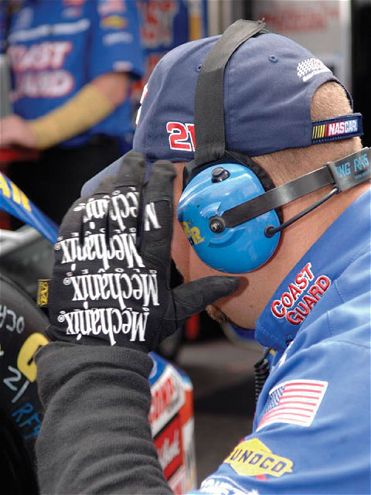 The Happy Hour glove from Mechanix Wear combines its original glove with a Kevlar sleeve heat shield.
The Happy Hour glove from Mechanix Wear combines its original glove with a Kevlar sleeve heat shield.
Task-specific is a buzzword you'll hear a lot in the glove business.
When choosing a glove, you should always remember the three F's. "Fit, feel, and function are the keys to finding the perfect glove," says Waalk. "The fit should be tight and snug. If you can't wear the glove all of the time, why wear it at all?" Essentially, your glove shouldn't feel like a glove at all. It should feel like a part of your body.
Feel for a mechanic glove is no different from the input feel for driving gloves and pedal feel for racing shoes previously discussed in the pages of Circle Track. "You need the capability and dexterity to feel, especially when you are picking up small nuts and bolts," says Mindy Stephens of Ringers Gloves. Glove makers go to great lengths to deliver that all-important feel through advanced materials research.
Those advanced materials bring us to our third and final F: function. The materials that manufacturers use determine the glove's specific function. For example, a glove made for intricate work may feature multilayered palms made of silicone that have non-slip patterns. That makes gripping small nuts and bolts easier. On the other end of the spectrum is a glove that a rear tire changer may wear. This glove offers either rubber or plastic protection on the top side of the fingers along with two-ply leather on the palms and a gauntlet that seals over the sleeves of the crew suit. In the cases of Mechanix Wear and Ringers, both companies offer gloves that use CarbonX and deliver a hefty SFI 3.3/20 rating. That's terrific if you're fueling the car during a pit stop, but it's overkill if you're just working on the brakes in the garage.
Remember Waalk's words-task specific. Whether you're a fabricator who bends a lot of sheetmetal or you're a professional tire changer, there is a glove for your specific task. The best resource to help you decide which glove you need is the manufacturer. Visit their Web sites or call them on the phone. They'll direct you to the glove that's right for your job.
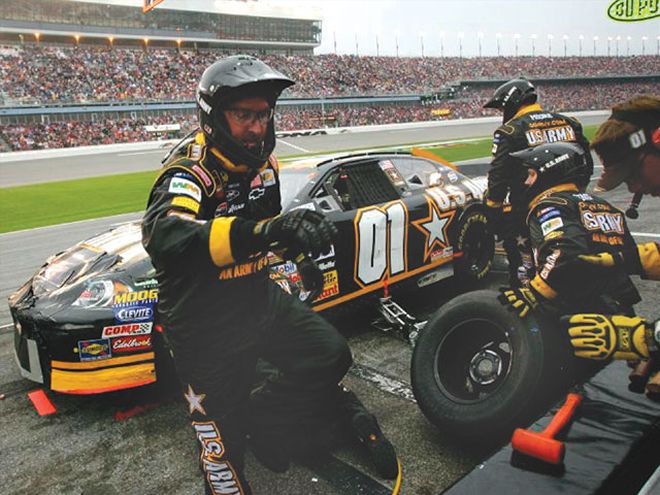
Shoes Shoe technology has come a long way in the past decade. Purpose-built crew shoes are available from just about every major safety equipment supplier. There are two types of pit crew shoes: those for guys who go over the wall, and those for guys who don't.
If you go over the wall, you want a shoe that blends traction, durability, safety, and comfort. Let's face it-pit road is the last place you want to fall down, and your shoes will keep you from doing so. Take a close look at what the soles are made of as well as the tread pattern. The tread pattern should provide good traction on a wide variety of surfaces, including dirt, mud, gravel, and asphalt, in wet and dry conditions. In addition, an over-the-wall shoe should have hidden laces or a non-lace form of closure. The less there is to trip over, the better. Regardless of your over-the-wall job, you'll also want a shoe with an SFI rating. Look for something with at least an SFI 3.3/10 rating.
If you don't go over the wall, traction is less important, but you still want to have durability, safety, and comfort. In any crew shoe, pay particular attention to whether or not your chosen shoe has a reinforced toe area. Remember our example at the beginning of this article? If you accidentally drop something heavy on your foot, you want to be sure that you're well protected. Also, be on the lookout for good ankle support. Remember, you are usually on your feet all day at the racetrack. With that in mind, many manufacturers build shoes with covered toe pads as well as gel-pad inserts for long-lasting comfort.
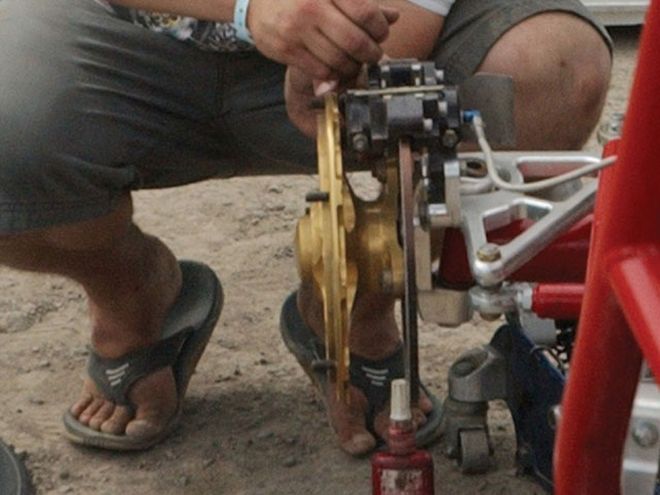 We at Circle Track like flip-flops as much as the next guy, but the pit area at a dirt track is the last place they should show up.
We at Circle Track like flip-flops as much as the next guy, but the pit area at a dirt track is the last place they should show up.
Eye Protection You gotta love those dudes on ER with the clear lens Gargoyles. Commonplace even in your local repair shop, eye protection seems to be one of the most overlooked accessories by crew members. But it shouldn't be. You may find yourself underneath a car, where you run the risk of having something fall into your eyes.
But you don't have to drop 80 bucks on a pair of Gargoyles to achieve good eye protection. Head over to your local home improvement warehouse, where you'll find a pair of ANSI-approved safety glasses for as little as $10. They look cool, too.
Over The Wall
Now that we've covered what you need to protect your hands, eyes, and feet, it's time to go over the wall. If you race in a series such as ARCA or NASCAR's Grand National Division, where pit stops are the norm, then the safety of your over-the-wall gang should be a top priority. Since we've already discussed gloves and shoes, we'll concentrate on two areas key to survival when you hop over 2 feet of concrete: helmets and firesuits.
Your Noggin When Nascar mandated helmets for pit crews a few years ago, there were not many choices. Thankfully, that has changed. So there is no reason to compromise your well-being by using a hockey or bicycle helmet. Those types of helmets are not made for our environment and should be nowhere near your head when the green flag drops.
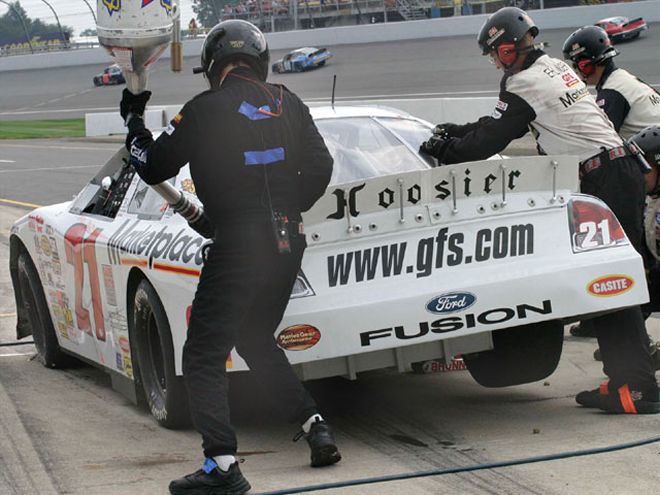 This crewman takes an added precaution by taping his laces.
This crewman takes an added precaution by taping his laces.
Helmets that carry a Snell rating of SA2005 are always a good choice. This rating signifies that the helmet has passed a test that includes multiple impact tests at two different angles in wet and dry conditions. To pass the tests and gain the rating, the helmet must have a thick shield, flame-retardant paint, trim, retention strap, and interior.
Another key feature that makes a helmet comfortable is the ventilation system. Be sure to look for a helmet with a good ventilation system that allows air to flow over various parts of your head. In addition, you should also make sure the helmet has room for radio headsets, sunglasses or goggles, and a visor system.
Here's a little trick. If you like to wear sunglasses or some other form of eye protection during pit stops, bring your eyewear and even your radio headset when your try on helmets. This way you can try on the whole setup at once and determine if the helmet is the right one for you.
If you're fueling the car, you'll want a full-face helmet with a faceshield and a fire-retardant inner lining. In all cases, do not take shortcuts when it comes to your helmet. Having the right one could save your life if things go badly during a pit stop.
Firesuits Good-quality firesuits are not just for drivers anymore. You'll remember that the Feb. '07 issue of Circle Track had an in-depth story on firesuits. Fortunately for crew members, more suit manufacturers are getting into the business of crew suits. Impact Racing makes a three-piece suit specifically designed for crewmen. These suits allow you to take off an outer layer jacket in between pit stops to keep cool. You are still protected by a fire-retardant under jacket and pants.
Bell Racing, new to the crew safety game but one of the most respected names in safety equipment, offers a crew firesuit that features padded elbows and padded knees. In addition, there are expansion areas around the arms and legs to provide additional mobility.
The key to finding a good crew firesuit is to try it on and simulate the movements you make when performing your job. Squat down, jump up, run, and so on. The more freely you can move in the suit, the better you'll perform your duties. We don't need to tell you how important that is.
Other Cool Stuff Many safety companies make accessories that not only keep you safe, but also make your job a lot easier. Kevlar sleeves are a popular item that keep your arms protected from heat. If our crewman from the beginning of the story was wearing one when Uncle Joey bumped into him, he never would have gotten burned.
Crew aprons do a great job of keeping uniforms clean when messy work is performed. Even fire-retardant aprons are available for added safety when you fuel a car during a pit stop. Most are made of some type of cotton/poly blend and have pockets in the front.
Speaking of tools, some manufacturers make toolbelts. These belts are a convenient way to keep your tools in reach but out of the way when working on your car.
Of course, when you're working on the car, you will eventually find yourself beneath the monster and flat on your back. This can be pretty uncomfortable, especially at a dirt track. As basic as this sounds, put something between your back and the ground-a mat, a crawler, or anything that will help ease the burden on your spine.
The Bottom Line
To many racers, safety while working around the car is almost an afterthought. But it shouldn't be. If you spend a few minutes to take the proper safety precautions, you can avoid a minor injury that could put a major dent in your racing weekend.